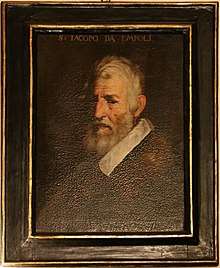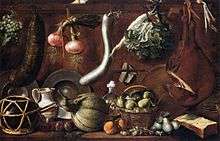Jacopo da Empoli
Jacopo da Empoli (30 April 1551 – 30 September 1640) was an Italian Florentine Reformist painter.

| Wikimedia Commons has media related to Jacopo da Empoli. |
Born in Florence as Jacopo Chimenti (Empoli being the birthplace of his father), he worked mostly in his native city. He apprenticed under Maso da San Friano. Like his contemporary in Counter-Maniera (Counter-Mannerism), Santi di Tito, he moved into a style often more crisp, less contorted, and less crowded than mannerist predecessors like Vasari. He collaborated with Alessandro Tiarini in some projects. His younger brother, Domenico Chimenti, born in Empoli, was also a painter.[1] Among his pupils were Felice Ficherelli, Giovanni Battista Brazzè (Il Bigio),[2] Giovanni Battista Vanni, and Virgilio Zaballi.[3]
Finally, working in a thematic often shunned by Florentine painters, after the 1620s he completed a series of exceptional still-life paintings.
Selected works

- Madonna in Glory with Saint Luke and Saint Ives (1579) - Louvre, Paris
- Sacrifice of Isaac (1590s) - Oil on copper, 32 x 25 cm, Uffizi, Florence
- Susanna and the Elders (1600) - Kunsthistorisches Museum, Vienna
- Sant'Eligio (1614) - Uffizi, Florence
- Carlo Borromeo and the Rospigliosi Family (1613) - Church of San Domenico, Pistoia
- Still Life with Games (1620s) - Oil on canvas, 114 x 152 cm, Private collection
- Judgement of Midas (1624) - Pistoia
- Saint Ives, Protector of Widows and Orphans - Palatine Gallery, Florence
- Adoration of Shepherds (attributed)
- Preaching of John the Baptist - San Niccolò Oltrarno, Florence.
- Michelangelo presents his model of San Lorenzo to Leo X (1617–19) - Casa Buonarroti, Florence
- The Wedding of Caterina de Medici to Henry II
- Drunkedness of Noah - Uffizi Gallery, Florence
- Saint Clair accepts the veil (vows) (1620) - Caen, France
- Final Judgement
- Pala della Concezione - San Bartolomeo
- "Three Marys At Tomb", -Blanton Art Museum, Austin, Texas
References
- Freedberg, Sydney J. (1993). "Painting in Italy, 1500-1600". Pelican History of Art. Penguin Books. pp. 630–632.
- Hobbes, James R. (1849). Picture collector's manual adapted to the professional man, and the amateur. T&W Boone, 29 Bond Street; Digitized by Googlebooks.
- Catalogo dei quadri che si conservano nella Pinacoteca Vannucci in Perugia, by Galleria Nazionale dell'Umbria, (1903) page 61.
- Ticozzi, Stefano (1830). Dizionario degli architetti, scultori, pittori, intagliatori in rame ed in pietra, coniatori di medaglie, musaicisti, niellatori, intarsiatori d’ogni etá e d’ogni nazione' (Volume 1). Gaetano Schiepatti; Digitized by Googlebooks, Jan 24, 2007. p. 214.
- Hobbes J.R. p. 81